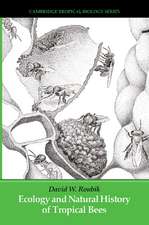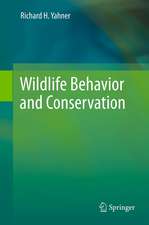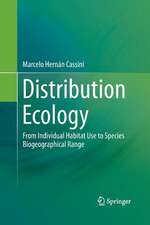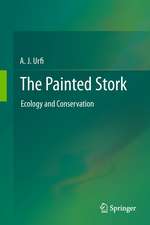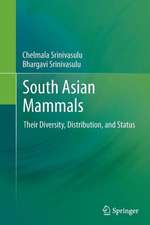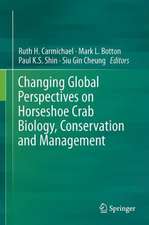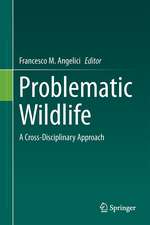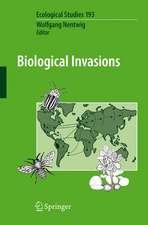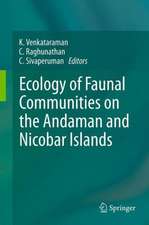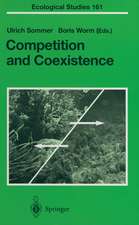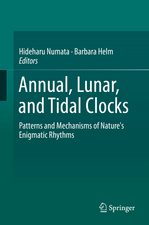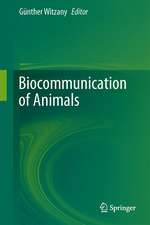Pot-Pollen in Stingless Bee Melittology
Editat de Patricia Vit, Silvia R.M. Pedro, David W. Roubiken Limba Engleză Hardback – 14 mar 2018
This book covers pot-pollen—the other product, besides honey, stored in cerumen pots by Meliponini. Critical assessment is given of stingless bee and pot-pollen biodiversity in the Americas, Africa, Asia and Oceania. Topics addressed include historical biogeography, cultural knowledge, bee foraging behavior, pollination, ecological interactions, health applications, microbiology, the natural history of bee nests, and chemical, bioactive and individual plant components in stored pollen.
Pot-pollen maintains the livelihoods of stingless bees and provides many interesting biological products that are just now beginning to be understood. The Meliponini have developed particular nesting biologies, uses of building materials, and an architecture for pollen storage. Environmental windows provide optimal temperature and availability of pollen sources for success in plant pollination and pollen storage. Palynological composition and pollen taxonomy are used to assess stingless honey bee pollination services. Pollen processing with microorganisms in the nest modifies chemical composition and bioactivity, and confers nutraceutical benefits to the honey and pollen widely relished by native people. Humans have always used stingless bees. Yet, sustainable meliponiculture (stingless bee-keeping) projects have so far lacked a treatise on pot-pollen, which experts provide in this transdisciplinary, groundbreaking volume.
| Toate formatele și edițiile | Preț | Express |
|---|---|---|
| Paperback (1) | 960.30 lei 6-8 săpt. | |
| Springer International Publishing – 14 ian 2019 | 960.30 lei 6-8 săpt. | |
| Hardback (1) | 968.03 lei 6-8 săpt. | |
| Springer International Publishing – 14 mar 2018 | 968.03 lei 6-8 săpt. |
Preț: 968.03 lei
Preț vechi: 1180.52 lei
-18% Nou
Puncte Express: 1452
Preț estimativ în valută:
185.23€ • 193.92$ • 153.27£
185.23€ • 193.92$ • 153.27£
Carte tipărită la comandă
Livrare economică 05-19 aprilie
Preluare comenzi: 021 569.72.76
Specificații
ISBN-13: 9783319618388
ISBN-10: 3319618385
Pagini: 780
Ilustrații: XXIV, 481 p. 132 illus., 87 illus. in color.
Dimensiuni: 178 x 254 mm
Greutate: 1.09 kg
Ediția:1st ed. 2018
Editura: Springer International Publishing
Colecția Springer
Locul publicării:Cham, Switzerland
ISBN-10: 3319618385
Pagini: 780
Ilustrații: XXIV, 481 p. 132 illus., 87 illus. in color.
Dimensiuni: 178 x 254 mm
Greutate: 1.09 kg
Ediția:1st ed. 2018
Editura: Springer International Publishing
Colecția Springer
Locul publicării:Cham, Switzerland
Cuprins
Forewords
Introduction
Acknowledgements
SECTION 1
Pollen and the Evolution of Mutualism
1. Pot-Pollen as a Discipline. What Does it Include?
1.1. Pot-Pollen and Palynology from an Ecological Point of View1.2. A Modern Synthesis of Bee-Pollen and Pot-Pollen Study 1.3. Plant Reproduction
1.4. Pollination 1.5. Pollen Biology and Palynology
1.6. Applied Pollen Taxonomy
2. Are Stingless Bees a Broadly Polylectic Group? An Empirical Study of the Adjustments Required for an Improved Assessment of Pollen Diet in Bees
2.1. Introduction
2.2. Pollen Specialization Categories in Bees2.3. Pollen Analysis of Samples2.4. Adjustment Calculations to Assess Pollen Specialization Categories in Stingless Bees2.4.1. Modifying the Number of Foraged Resource Items: Threshold Values and Pollen Type Versus Pollen Species
2.4.2. Modifying the Number of Available Resources: Spatial and Temporal Adjustments
2.5. The Importance of an Appropriate Assessment of Pollen Specialization in Bees: Factors Causing Low Number of Foraged Items2.5.1 Abundant Versus Minor Pollen Types2.5.2 Recruitment Behaviour
2.5.3 Intra-nest Pollen Analysis
2.6. Factors Causing High Number of Available Items<
2.7. Polylecty, Broad Polylecty or Simply degrees of polylecty?<
3. Pollen collected by stingless bees: a contribution to understand Amazonian biodiversity
3.1. Introduction
3.1.1 Origin and Evolution of Plant-Bee Interactions
3.2. The Use of Pollen Analysis in the Study of Bees in the Amazon Rainforest
3.3. Diversity of Plants, Stingless Bees and their Interactions in Central Amazon3.4. Amazonian Bee Diet, Biology and Suggested Interactions Potentially Leading to Pollination3.5. How to Improve Meliponiculture for Sustainable Development in the Amazon 3.6. Conclusions
4. The Stingless Honey Bees (Apidae, Apinae: Meliponini) in Panama, and Ecology from Pollen Analysis
4.1. An Introduction to the Stingless Honey Bees and Pot-Pollen, in Panama4.2. Pollen niche, relative specialization, and pollen spectrum4.2.1 Qualitative and quantitative analyses
4.2.2 Field bee short-term resource selection
4.2.3 Pollen of popular meliponines , Africanized honeybees and lesser known species
4.2.4 Pollination ecology and population biology
4.2.5 Conclusions and ecological perspective
5. The value of plants for the Mayan stingless honey bee Melipona beecheii (Apidae: Meliponini): a pollen-based study in the Yucatán Peninsula, Mexico5.1. Understanding the Ecology of a Mayan Resource and Cultural Icon5.2. Baseline Studies of Invasive Honeybees and Native Neotropical Bees5.3. Fieldwork 5.4. Pollen Analysis from Pot-Pollen Samples
5.5. Understanding Bee Resource Use in Dynamic Natural Environments
6. Melittopalynological Studies of Stingless Bees from East Coast of Peninsular Malaysia6.1. Introduction
^len Collection by Heterotrigona itama in Tropical Island of Taman Tropika Kenyir, Terengganu 6.3. Pollen Collection and Abundance among Colonies of Lepidotrigona terminata from a Meliponary in Besut, Terengganu
6.4. Selected Flowers Producing Pollen Preferred by Stingless Bees in Terengganu 6.5. Conclusions
7. The Contribution of Palynological Surveys to Stingless Bee Conservation: a Case Study with Melipona subnitida7.1. Introduction7.2. Floral Resources-Dynamics: Pot-Pollen versus Pollen from the Bees' Body 7.3. Melittopalynology as Tool for Restoration Strategies: Suitable Foraging Habitats
7.4. Concluding Remarks and Future Steps
8. Pollen Storage by Melipona quadrifasciata anthidioides in a Protected Urban Atlantic Forest Area of Rio de Janeiro, Brazil8.1. Introduction 8.2. Getting Pollen Loads and Pollen Grains by M. quadrifasciata anthidioides
8.3. Palynological Characteristics of Pollen Batches Collected from the Baskets of M. quadrifasciata anthidioides8.3.1 Monofloral Pollen Loads
8.3.2 Bifloral Pollen Loads8.3.3 Heterofloral Pollen Loads
8.3.4 Additional Pollen Types
8.3.5 Additional Structured Elements
8.4. Plant Families, Genera and Species Mostly Visited by M. quadrifasciata anthidioides8.5. Conclusion
9. Angiosperm Resources for Stingless Bees (Apidae, Meliponini): A Pot-Pollen Melittopalynological Study in the Gulf of Mexico9.1. Introduction
9.2. Background of Melittopalynological Studies in Mexico9.3. Methods and Study Areas 9.4. Floral Resources Foraged by Melipona beecheii in the State of Campeche
9.4.1 Angiosperm Resources for Melipona beecheii
9.4.2 Physicochemical Analyses of Melipona beecheii Pot-Honey 9.5. Meliponiculture and Melitopalynological Study of Pot-Honey and Pot-Pollen in Veracruz
9.5.1 INANA’s Sustainable Meliponiculture
9.5.2 Angiosperm Resources for Scaptotrigona mexicana, Plebeia sp. and Melipona beecheii in Veracruz9.6. Analysis of the Plant Preferences of Stingless Bees in Campeche and Veracruz, Gulf of Mexico
9.7. Angiosperms Recorded in Systematic Mexican Melittopalynological Studies of Stingless Bees 9.8. General Considerations
10. Annual Foraging Patterns of the Maya Bee Melipona beecheii (Bennett, 1831) in Quintana Roo, Mexico
10.1. Introduction 10.2. A case study
10.2.1 Field observations: registering bees activity10.2.2. Foraging Activity to Collect Pollen and Nectar
10.2.3. Stored Pot-Honey and Pot-Pollen Reserves
10.2.4. Offspring
10.3. Correlations Between the Studied Factors<
11. Crop Pollination by Stingless Bees
11.1. Introduction 11.2. Characteristics of Stingless Bees as Pollinators
11.3. Field Crop Pollination by Stingless Bees
11.4. Greenhouse Crop Pollination by Stingless Bees11.5. Stingless Bee Management under Greenhouse Conditions 11.6. Perspectives
12. Stingless Bees as Potential Pollinators in Agroecosystems in Argentina: Inferences from Pot-Pollen Studies in Natural Environments12.1. Introduction
12.2. Potential Pollination by Stingless Bees: Intrinsic and Extrinsic Factors12.2.1 Advantages and Disadvantages of a Reduced-Moderate Flight Range in Stingless Bees
12.2.2. Pollination Using Ground Nesting Stingless Bees
12.3. Pollen Spectra of Pot-Pollen in Colonies of Stingless Bees from Natural Environments 12.4. Crops Potentially Pollinated by Stingless Bees in Argentina
12.5. Spatial Variation of Crops in Argentina 12.6. Temporal Variation of Flower Availability in Agroecosystems
12.7. Crop and Non-Crop Flowerings Present in Agroecosystems Beneficial for the Maintenance of Permanent Stingless Bee Colonies12.7.1. Pollinating the Target Crop
12.7.2. Weeds and Edge Vegetation as Complementary Flowerings for Permanent Stingless Bee Colonies12.7.3. Diversified Agroecosystems as Best Habitat for Stingless Bee Pollination and Colony Management
12.8. Case Study: Pollination of Strawberries with Plebeia catamarcensis (Holmberg) in Santa Fe, Central Argentina
12.8.1. Strawberry Cultivation in Argentina
12.8.2 The Strawberry in Santa Fe
12.8.3 Meliponini: Potential Pollinators in Santa Fe Strawberry Crops
SECTION 2
Biodiversity, Behavior and Microorganisms of the Stingless Bees (Meliponini)
13. Stingless bees (Hymenoptera: Apoidea: Meliponini) from Gabon
13.1. Introduction
13.2. Taxonomy and Morphological Diversity of Stingless Bees in Gabon13.3. Distribution of Stingless Bee Fauna in Gabon 13.4. Biology, Ecology and Nesting Behavior of the Stingless Bees
13.5. Knowledge and Traditional Use of Stingless Bees in Gabon
13.6. Conclusion 14. Pushing 100 Species: Meliponines (Apidae: Meliponini) in a Parcel of Western Amazonian Forest at Yasuní Biosphere Reserve, Ecuador14.1. Yasuní Forest and Melittological Background
14.2. Discovering Meliponine Biodiversity14.3. Species Accounts and Frequency 14.4. Insights from Comparative Morphology and other Rich Amazonian Areas
14.5. Bioprospecting for Pollination Knowledge and Sustainable Exploitation
15. Diversity of Stingless Bees in Ecuador, Pot-Pollen Standards and Meliponiculture Fostering a Living Museum for Meliponini of the World
15.1. Introduction 15.2. Megabiodiversity of Stingless Bees in Ecuador
15.3. A Revised Ecuadorian Honey Norm and Approach to Pot-Pollen Standards15.4. Stingless Bee Keepers are Crucial for the Heritage and Conservation Mission 15.5. A Stingless Bee Window to Look at Climate Warming
15.5. Why a Living Museum to Embrace Meliponini of the World?
16. Nesting Ecology of Stingless Bees in Africa
16.1. Introduction 16.2. Meliponine Origin, Dispersal and Richness
16.3. Stingless Bee Species in Africa 16.4. Stingless Bee Nest Architecture
16.5. African Stingless Bee Nesting Behavior
17. On the Trophic Niche of Bees in Cerrado Areas of Brazil and Yeasts in their Stored Pollen17.1. Introduction
17.2. Pollen Harvested by Native Bees of the Cerrado 17.3. Yeasts in Stored Pollen: Diversity and Ecological Role
18. A Review of the Artificial Diets Used as Pot-Pollen Substitutes
18.1. Introduction
18.1.1 Aim of the Chapter18.1.2 How do Stingless Bees Harvest and Store their Food?18.2. The Fermentation Process in Stingless Bees Storage Pots
18.2.1 General Characteristics of Pollen Fermentation
18.2.2 Microbial fermentation and nutritional enhancement of pollen18.2.3 Impacts of Exogenous Compounds in Pollen
18.3. Microorganisms Present in Pot-Pollen
18.3.1 Generalities of host-associated microorganisms
18.3.2 Bacteria
18.3.3 Yeasts18.3.4 Filamentous Fungi18.4. Development of Artificial Diets
19. Yeast and Bacterial Composition in Pot-Pollen Recovered from Meliponini in Colombia: Prospects for a Promising Biological Resource 19.1. Introduction19.2. General Properties of Corbicular Bee-Derived Pollen19.3. The Key Bacterial Assemblages Known to be Associated with Bees and Pollen 19.4. Key Features of Yeast Communities Present in Pollen Collected by Bees: Recovery and Identification of Yeasts found in Pollen Collected by Four Genera of Stingless Bees from Colombia
19.5 Final remarks
SECTION 3
Stingless Bees in Culture and Traditions
20. Cultural, Psychological and Organoleptic Factors Related to the Use of Stingless Bees by Rural Residents of Northern Misiones, Argentina
20.1. Introduction
20.2. Southernmost Atlantic Forest Ecoregion20.3. Ethnobiological Field Work
20.4. Cultural, Psychological and Organoleptic Factors Context
20.4.1 Cultural Factors
20.4.2 Psychological Factors
20.4.3 Organoleptic Factors
20.5. Context of Exploitation of Stingless Bees20.6. Cultural and Psychological Factors Related to the Use of Stingless Bees
20.7. Relationships Between Pot-Honey, Pot-Pollen, and Cultural, Psychological Factors
20.8. Conclusions and Future Challenges
21. The Maya Universe in a Pollen Pot Native Stingless Bees in Precolumbian Maya Art
21.1. Introduction 21.2. Maya Bee Myths
21.3. Small Format Modelled Sculptures21.3.1 Small Clay Bee
21.3.2 Ceramic Beehive
21.3.3 Censers
^; Bees and Stingless Bee Keeping in a Sacred Maya Book21.4.1 Melipona beecheii in the Tro-Cortesianus Codex
21.4.2 Hobon
21.5. A World View of Humankind through a Bee Model as Told by a H-men, a Traditional Maya Priest
21.6. The Maya Universe in a Pollen Pot21.6.1 Once upon a Time, Long, Long Ago, there were Bees….21.7. ‘The Flower Dust’
SECTION 4
Chemical Composition, Bioactivity and Biodiversity of Pot-Pollen
22. Nutritional Composition of Pot-Pollen from Four Species of Stingless Bees (Meliponini) in South East Asia22.1. Introduction
22.2. Shape and Volume of Stingless Bee Pollen Pots
22.3. Nutritional Composition
<22.3.1 Macronutrients of Pot-Pollen22.3.2 Mineral Analysis
22.3.3 Fatty Acid Analysis
22.3.4 Amino Acid Analysis
22.4. Botanical Origin
22.5. Conclusions, Suggestion and Future Research
23. Characterization of Scaptotrigona mexicana Pot-Pollen from Veracruz, Mexico
23.1. Introduction
23.2. Traditional Values of Scaptotrigona mexicana 23.3. Importance of Pot-Pollen in Meliponiculture <
23.4. Palynological Analyses of Scaptotrigona mexicana Pot-pollen from Central Veracruz, Mexico
23.5. Chemical Parameters of Scaptotrigona mexicana Pot-Pollen from Veracruz, Mexico
23.6. Elemental Composition of Scaptotrigona mexicana Pot-pollen from Central Veracruz, Mexico
23.7. Conclusions and Perspectives on Scaptotrigona mexicana Pot-Pollen in Mexico
24. Chemical Characterization and Bioactivity of Tetragonisca angustula Pot-Pollen from Mérida, Venezuela
24.1. Introduction
24.2. Proximal Analysis of Tetragonisca angustula Pot-Pollen from Mérida
24.3. Methods to Quantify Flavonoids, Polyphenols, Proteins, and Antioxidant Activity in Ethanolic Extracts of Tetragonisca angustula Pot-Pollen24.3.1 Preparation of Pot-Pollen Ethanolic Extracts
24.3.2 Flavonoid Content
24.3.3 Polyphenol Content
24.3.4 Protein Content
24.3.5 Antioxidant Activity by the ABTS+• Method24.3.6 Antioxidant Activity (AOA) by Fenton-Type Reaction24.3.7 Hydroxyl Radical Assay
24.4. Biochemical Components and Antioxidant Activity of Ethanolic Extracts from Tetragonisca angustula Pot-Pollen 4.1 Preparation of Pot-Pollen Ethanolic Extracts
24.5. Conclusions
25. Chemical, Microbiological and Palynological composition of the ‘Samburá’ Melipona scutellaris Pot-Pollen
25.1. Introduction
25.2. The ‘Samburá’ of the True “Uruçú” Bee
25.3. Physicochemical Characteristics of ‘Samburá’
25.3.1 Moisture
25.3.2 Ash25.3.3 Lipids25.3.4 Protein<
25.3.5 Fiber
25.3.6 Carbohydrates
25.3.7 pH
25.3.8 Free Acidity
25.3.9 Water activity (Aw)
25.3.10 Total Energy Value25.4. Microbiological Characteristics of ‘Samburá’ 25.5. Pollen Analysis
26. Characterization of Pot-Pollen from Southern Venezuela
26.1. Introduction26.2. Venezuelan Stingless Bees 26.3. Botanical Origin of Venezuelan Pot-Pollen
26.4. Proximal Analysis of Venezuelan Pot-Pollen
26.5 Bioactive Components and Antioxidant Activity of Pot-Pollen Ethanolic Extracts26.5.1 Preparation of the Ethanolic Extracts
26.5.2 Bioactive components
26.5.3 Flavonoids by HPLC-UV26.5.4 Antioxidant Activity of Venezuelan Pot-Pollen Homogenates26.6. Conclusions
27. Bioactivity and Botanical Origin of Austroplebeia and Tetragonula Australian Pot-Pollen
27.1. Introduction
27.2. Nutraceutical Properties of Bee Pollen 27.3. Botanical Origin of Australian Pot-Pollen
27.4. Flavonoids, Polyphenols and Antioxidant Activity
27.5. Antibacterial Activity of Australian Pot-Pollen
27.6. Conclusions
28. Antibacterial Activity of Ethanolic Extracts of Pot-Pollen from Eight Meliponine Species from Venezuela
28.1. Introduction
28.1.1 Biological Potential of Pollen Stored in Bee Nests
28.1.2 Aim of the Chapter
28.2. Pot-Pollen Samples and Ethanolic Extraction
28.3. Well Diffusion Agar and Minimal Inhibitory Concentration Methods
28.4. Antibacterial Activity of Venezuelan Pot-Pollen Ethanolic Extracts
28.4.1 Inhibition Zone Diameters28.4.2 Minimal Inhibitory Concentrations
28.4.3 Antibacterial Activity of Pollen and Polyphenols
28.4. Conclusions
29. Metabolomics of Pot-Pollen from Three Species of Australian Stingless Bees (Meliponini)
29.1. Introduction
29.1.1 Historical Accounts of Australian Pot-Pollen29.1.2 Health Benefits of Bee Pollen
29.1.3 Botanical Sources within Flight Range<
29.1.4 Food Security
29.1.5 Research in Australian Meliponini Bee Products
29.1.6 Aim of the Chapter
29.2. Methods of Chromatographic Analysis of Pot-Pollen29.2.1 Sampling Pot-Pollen from Bee Hives of Australian Meliponini
29.2.2 Extraction
29.2.3 Volatiles by HS-SPME-GC-MS
29.2.4 Chemical constituents by UPLC-DAD-ESI(-)-MS/MS
29.2.5 Targeted Analyses of Pyrrolizidine Alkaloids (PA) by ESI(+)-MS/MS
29.2.6 Metabolomics of Pot-Pollen VOCs and Phenolics29.3. Chemometrics of Australian Meliponini Pot-Pollen
29.3.1 Volatile Organic Compounds (VOCs)
29.3.2 Secondary Metabolites by LC-UV-HRMS/MS
29.3.3 Chemometrics Using Open Source Data
29.4. Future studies of Australian Pot-Pollen
29.4.1 Botanical and ecological studies29.4.2 Microbiological and Metabolomics of Australian Pot-Pollen
29.4.3 Recent Trends in Australian Meliponiculture
29.5. Conclusions
SECTION 6
Marketing and Standards of Pot-Pollen
30. Rural-Urban Meliponiculture and Ecosystems in Neotropical areas. Scaptotrigona, a Resilient Stingless Bee?
30.1. Introduction 30.2. Initiatives to Revitalize Stingless Bee Keeping 30.3. Traditional Knowledge Involving Scaptotrigona
30.4. One stingless bee, Scaptotrigona over Melipona
30.5. Naming Pot-Honey and Pot-Pollen in Labels of Commercial Products
30.6. Future of Social Interventions in Meliponiculture 31. Pot-Pollen “Samburá” Marketing in Brazil, and Suggested Legisation
31.1. Introduction
31.2. Pot-Pollen is Known as ‘Samburá’ in Brazil 31.3. Meliponíne Species Used for the Production of ‘Samburá’
31.4. Harvesting and Processing 31.5. Marketing of Meliponine ‘Samburá’
31.6. Cultural Aspects of Pot-Pollen Consumption in Brazil 31.7. Strategies to Increase the Production of ´Samburá’
31.8. Seasonality of Pot-Pollen
31.9. Pot-Pollen Production Initiatives in Brazilian States
31.10. Suggested ‘Samburá’ Standards for Pot-Pollen Legislation
Appendix A
Ethnic Names of Stingless Bees
Appendix B
Microorganisms Associated with Stingless Bees or Used to Test Antimicrobial Activity (AM)
ELECTRONIC SUPPLEMENTAL MATERIAL
Appendix C
Taxonomic Index of Bees
Appendix D
List of Bee Taxa
Appendix E
Taxonomic Index of Plant Families
Appendix F
List of Plant Taxa Used by Bees
Introduction
Acknowledgements
SECTION 1
Pollen and the Evolution of Mutualism
1. Pot-Pollen as a Discipline. What Does it Include?
1.1. Pot-Pollen and Palynology from an Ecological Point of View1.2. A Modern Synthesis of Bee-Pollen and Pot-Pollen Study 1.3. Plant Reproduction
1.4. Pollination 1.5. Pollen Biology and Palynology
1.6. Applied Pollen Taxonomy
2. Are Stingless Bees a Broadly Polylectic Group? An Empirical Study of the Adjustments Required for an Improved Assessment of Pollen Diet in Bees
2.1. Introduction
2.2. Pollen Specialization Categories in Bees2.3. Pollen Analysis of Samples2.4. Adjustment Calculations to Assess Pollen Specialization Categories in Stingless Bees2.4.1. Modifying the Number of Foraged Resource Items: Threshold Values and Pollen Type Versus Pollen Species
2.4.2. Modifying the Number of Available Resources: Spatial and Temporal Adjustments
2.5. The Importance of an Appropriate Assessment of Pollen Specialization in Bees: Factors Causing Low Number of Foraged Items2.5.1 Abundant Versus Minor Pollen Types2.5.2 Recruitment Behaviour
2.5.3 Intra-nest Pollen Analysis
2.6. Factors Causing High Number of Available Items<
2.7. Polylecty, Broad Polylecty or Simply degrees of polylecty?<
3. Pollen collected by stingless bees: a contribution to understand Amazonian biodiversity
3.1. Introduction
3.1.1 Origin and Evolution of Plant-Bee Interactions
3.2. The Use of Pollen Analysis in the Study of Bees in the Amazon Rainforest
3.3. Diversity of Plants, Stingless Bees and their Interactions in Central Amazon3.4. Amazonian Bee Diet, Biology and Suggested Interactions Potentially Leading to Pollination3.5. How to Improve Meliponiculture for Sustainable Development in the Amazon 3.6. Conclusions
4. The Stingless Honey Bees (Apidae, Apinae: Meliponini) in Panama, and Ecology from Pollen Analysis
4.1. An Introduction to the Stingless Honey Bees and Pot-Pollen, in Panama4.2. Pollen niche, relative specialization, and pollen spectrum4.2.1 Qualitative and quantitative analyses
4.2.2 Field bee short-term resource selection
4.2.3 Pollen of popular meliponines , Africanized honeybees and lesser known species
4.2.4 Pollination ecology and population biology
4.2.5 Conclusions and ecological perspective
5. The value of plants for the Mayan stingless honey bee Melipona beecheii (Apidae: Meliponini): a pollen-based study in the Yucatán Peninsula, Mexico5.1. Understanding the Ecology of a Mayan Resource and Cultural Icon5.2. Baseline Studies of Invasive Honeybees and Native Neotropical Bees5.3. Fieldwork 5.4. Pollen Analysis from Pot-Pollen Samples
5.5. Understanding Bee Resource Use in Dynamic Natural Environments
6. Melittopalynological Studies of Stingless Bees from East Coast of Peninsular Malaysia6.1. Introduction
^len Collection by Heterotrigona itama in Tropical Island of Taman Tropika Kenyir, Terengganu 6.3. Pollen Collection and Abundance among Colonies of Lepidotrigona terminata from a Meliponary in Besut, Terengganu
6.4. Selected Flowers Producing Pollen Preferred by Stingless Bees in Terengganu 6.5. Conclusions
7. The Contribution of Palynological Surveys to Stingless Bee Conservation: a Case Study with Melipona subnitida7.1. Introduction7.2. Floral Resources-Dynamics: Pot-Pollen versus Pollen from the Bees' Body 7.3. Melittopalynology as Tool for Restoration Strategies: Suitable Foraging Habitats
7.4. Concluding Remarks and Future Steps
8. Pollen Storage by Melipona quadrifasciata anthidioides in a Protected Urban Atlantic Forest Area of Rio de Janeiro, Brazil8.1. Introduction 8.2. Getting Pollen Loads and Pollen Grains by M. quadrifasciata anthidioides
8.3. Palynological Characteristics of Pollen Batches Collected from the Baskets of M. quadrifasciata anthidioides8.3.1 Monofloral Pollen Loads
8.3.2 Bifloral Pollen Loads8.3.3 Heterofloral Pollen Loads
8.3.4 Additional Pollen Types
8.3.5 Additional Structured Elements
8.4. Plant Families, Genera and Species Mostly Visited by M. quadrifasciata anthidioides8.5. Conclusion
9. Angiosperm Resources for Stingless Bees (Apidae, Meliponini): A Pot-Pollen Melittopalynological Study in the Gulf of Mexico9.1. Introduction
9.2. Background of Melittopalynological Studies in Mexico9.3. Methods and Study Areas 9.4. Floral Resources Foraged by Melipona beecheii in the State of Campeche
9.4.1 Angiosperm Resources for Melipona beecheii
9.4.2 Physicochemical Analyses of Melipona beecheii Pot-Honey 9.5. Meliponiculture and Melitopalynological Study of Pot-Honey and Pot-Pollen in Veracruz
9.5.1 INANA’s Sustainable Meliponiculture
9.5.2 Angiosperm Resources for Scaptotrigona mexicana, Plebeia sp. and Melipona beecheii in Veracruz9.6. Analysis of the Plant Preferences of Stingless Bees in Campeche and Veracruz, Gulf of Mexico
9.7. Angiosperms Recorded in Systematic Mexican Melittopalynological Studies of Stingless Bees 9.8. General Considerations
10. Annual Foraging Patterns of the Maya Bee Melipona beecheii (Bennett, 1831) in Quintana Roo, Mexico
10.1. Introduction 10.2. A case study
10.2.1 Field observations: registering bees activity10.2.2. Foraging Activity to Collect Pollen and Nectar
10.2.3. Stored Pot-Honey and Pot-Pollen Reserves
10.2.4. Offspring
10.3. Correlations Between the Studied Factors<
11. Crop Pollination by Stingless Bees
11.1. Introduction 11.2. Characteristics of Stingless Bees as Pollinators
11.3. Field Crop Pollination by Stingless Bees
11.4. Greenhouse Crop Pollination by Stingless Bees11.5. Stingless Bee Management under Greenhouse Conditions 11.6. Perspectives
12. Stingless Bees as Potential Pollinators in Agroecosystems in Argentina: Inferences from Pot-Pollen Studies in Natural Environments12.1. Introduction
12.2. Potential Pollination by Stingless Bees: Intrinsic and Extrinsic Factors12.2.1 Advantages and Disadvantages of a Reduced-Moderate Flight Range in Stingless Bees
12.2.2. Pollination Using Ground Nesting Stingless Bees
12.3. Pollen Spectra of Pot-Pollen in Colonies of Stingless Bees from Natural Environments 12.4. Crops Potentially Pollinated by Stingless Bees in Argentina
12.5. Spatial Variation of Crops in Argentina 12.6. Temporal Variation of Flower Availability in Agroecosystems
12.7. Crop and Non-Crop Flowerings Present in Agroecosystems Beneficial for the Maintenance of Permanent Stingless Bee Colonies12.7.1. Pollinating the Target Crop
12.7.2. Weeds and Edge Vegetation as Complementary Flowerings for Permanent Stingless Bee Colonies12.7.3. Diversified Agroecosystems as Best Habitat for Stingless Bee Pollination and Colony Management
12.8. Case Study: Pollination of Strawberries with Plebeia catamarcensis (Holmberg) in Santa Fe, Central Argentina
12.8.1. Strawberry Cultivation in Argentina
12.8.2 The Strawberry in Santa Fe
12.8.3 Meliponini: Potential Pollinators in Santa Fe Strawberry Crops
SECTION 2
Biodiversity, Behavior and Microorganisms of the Stingless Bees (Meliponini)
13. Stingless bees (Hymenoptera: Apoidea: Meliponini) from Gabon
13.1. Introduction
13.2. Taxonomy and Morphological Diversity of Stingless Bees in Gabon13.3. Distribution of Stingless Bee Fauna in Gabon 13.4. Biology, Ecology and Nesting Behavior of the Stingless Bees
13.5. Knowledge and Traditional Use of Stingless Bees in Gabon
13.6. Conclusion 14. Pushing 100 Species: Meliponines (Apidae: Meliponini) in a Parcel of Western Amazonian Forest at Yasuní Biosphere Reserve, Ecuador14.1. Yasuní Forest and Melittological Background
14.2. Discovering Meliponine Biodiversity14.3. Species Accounts and Frequency 14.4. Insights from Comparative Morphology and other Rich Amazonian Areas
14.5. Bioprospecting for Pollination Knowledge and Sustainable Exploitation
15. Diversity of Stingless Bees in Ecuador, Pot-Pollen Standards and Meliponiculture Fostering a Living Museum for Meliponini of the World
15.1. Introduction 15.2. Megabiodiversity of Stingless Bees in Ecuador
15.3. A Revised Ecuadorian Honey Norm and Approach to Pot-Pollen Standards15.4. Stingless Bee Keepers are Crucial for the Heritage and Conservation Mission 15.5. A Stingless Bee Window to Look at Climate Warming
15.5. Why a Living Museum to Embrace Meliponini of the World?
16. Nesting Ecology of Stingless Bees in Africa
16.1. Introduction 16.2. Meliponine Origin, Dispersal and Richness
16.3. Stingless Bee Species in Africa 16.4. Stingless Bee Nest Architecture
16.5. African Stingless Bee Nesting Behavior
17. On the Trophic Niche of Bees in Cerrado Areas of Brazil and Yeasts in their Stored Pollen17.1. Introduction
17.2. Pollen Harvested by Native Bees of the Cerrado 17.3. Yeasts in Stored Pollen: Diversity and Ecological Role
18. A Review of the Artificial Diets Used as Pot-Pollen Substitutes
18.1. Introduction
18.1.1 Aim of the Chapter18.1.2 How do Stingless Bees Harvest and Store their Food?18.2. The Fermentation Process in Stingless Bees Storage Pots
18.2.1 General Characteristics of Pollen Fermentation
18.2.2 Microbial fermentation and nutritional enhancement of pollen18.2.3 Impacts of Exogenous Compounds in Pollen
18.3. Microorganisms Present in Pot-Pollen
18.3.1 Generalities of host-associated microorganisms
18.3.2 Bacteria
18.3.3 Yeasts18.3.4 Filamentous Fungi18.4. Development of Artificial Diets
19. Yeast and Bacterial Composition in Pot-Pollen Recovered from Meliponini in Colombia: Prospects for a Promising Biological Resource 19.1. Introduction19.2. General Properties of Corbicular Bee-Derived Pollen19.3. The Key Bacterial Assemblages Known to be Associated with Bees and Pollen 19.4. Key Features of Yeast Communities Present in Pollen Collected by Bees: Recovery and Identification of Yeasts found in Pollen Collected by Four Genera of Stingless Bees from Colombia
19.5 Final remarks
SECTION 3
Stingless Bees in Culture and Traditions
20. Cultural, Psychological and Organoleptic Factors Related to the Use of Stingless Bees by Rural Residents of Northern Misiones, Argentina
20.1. Introduction
20.2. Southernmost Atlantic Forest Ecoregion20.3. Ethnobiological Field Work
20.4. Cultural, Psychological and Organoleptic Factors Context
20.4.1 Cultural Factors
20.4.2 Psychological Factors
20.4.3 Organoleptic Factors
20.5. Context of Exploitation of Stingless Bees20.6. Cultural and Psychological Factors Related to the Use of Stingless Bees
20.7. Relationships Between Pot-Honey, Pot-Pollen, and Cultural, Psychological Factors
20.8. Conclusions and Future Challenges
21. The Maya Universe in a Pollen Pot Native Stingless Bees in Precolumbian Maya Art
21.1. Introduction 21.2. Maya Bee Myths
21.3. Small Format Modelled Sculptures21.3.1 Small Clay Bee
21.3.2 Ceramic Beehive
21.3.3 Censers
^; Bees and Stingless Bee Keeping in a Sacred Maya Book21.4.1 Melipona beecheii in the Tro-Cortesianus Codex
21.4.2 Hobon
21.5. A World View of Humankind through a Bee Model as Told by a H-men, a Traditional Maya Priest
21.6. The Maya Universe in a Pollen Pot21.6.1 Once upon a Time, Long, Long Ago, there were Bees….21.7. ‘The Flower Dust’
SECTION 4
Chemical Composition, Bioactivity and Biodiversity of Pot-Pollen
22. Nutritional Composition of Pot-Pollen from Four Species of Stingless Bees (Meliponini) in South East Asia22.1. Introduction
22.2. Shape and Volume of Stingless Bee Pollen Pots
22.3. Nutritional Composition
<22.3.1 Macronutrients of Pot-Pollen22.3.2 Mineral Analysis
22.3.3 Fatty Acid Analysis
22.3.4 Amino Acid Analysis
22.4. Botanical Origin
22.5. Conclusions, Suggestion and Future Research
23. Characterization of Scaptotrigona mexicana Pot-Pollen from Veracruz, Mexico
23.1. Introduction
23.2. Traditional Values of Scaptotrigona mexicana 23.3. Importance of Pot-Pollen in Meliponiculture <
23.4. Palynological Analyses of Scaptotrigona mexicana Pot-pollen from Central Veracruz, Mexico
23.5. Chemical Parameters of Scaptotrigona mexicana Pot-Pollen from Veracruz, Mexico
23.6. Elemental Composition of Scaptotrigona mexicana Pot-pollen from Central Veracruz, Mexico
23.7. Conclusions and Perspectives on Scaptotrigona mexicana Pot-Pollen in Mexico
24. Chemical Characterization and Bioactivity of Tetragonisca angustula Pot-Pollen from Mérida, Venezuela
24.1. Introduction
24.2. Proximal Analysis of Tetragonisca angustula Pot-Pollen from Mérida
24.3. Methods to Quantify Flavonoids, Polyphenols, Proteins, and Antioxidant Activity in Ethanolic Extracts of Tetragonisca angustula Pot-Pollen24.3.1 Preparation of Pot-Pollen Ethanolic Extracts
24.3.2 Flavonoid Content
24.3.3 Polyphenol Content
24.3.4 Protein Content
24.3.5 Antioxidant Activity by the ABTS+• Method24.3.6 Antioxidant Activity (AOA) by Fenton-Type Reaction24.3.7 Hydroxyl Radical Assay
24.4. Biochemical Components and Antioxidant Activity of Ethanolic Extracts from Tetragonisca angustula Pot-Pollen 4.1 Preparation of Pot-Pollen Ethanolic Extracts
24.5. Conclusions
25. Chemical, Microbiological and Palynological composition of the ‘Samburá’ Melipona scutellaris Pot-Pollen
25.1. Introduction
25.2. The ‘Samburá’ of the True “Uruçú” Bee
25.3. Physicochemical Characteristics of ‘Samburá’
25.3.1 Moisture
25.3.2 Ash25.3.3 Lipids25.3.4 Protein<
25.3.5 Fiber
25.3.6 Carbohydrates
25.3.7 pH
25.3.8 Free Acidity
25.3.9 Water activity (Aw)
25.3.10 Total Energy Value25.4. Microbiological Characteristics of ‘Samburá’ 25.5. Pollen Analysis
26. Characterization of Pot-Pollen from Southern Venezuela
26.1. Introduction26.2. Venezuelan Stingless Bees 26.3. Botanical Origin of Venezuelan Pot-Pollen
26.4. Proximal Analysis of Venezuelan Pot-Pollen
26.5 Bioactive Components and Antioxidant Activity of Pot-Pollen Ethanolic Extracts26.5.1 Preparation of the Ethanolic Extracts
26.5.2 Bioactive components
26.5.3 Flavonoids by HPLC-UV26.5.4 Antioxidant Activity of Venezuelan Pot-Pollen Homogenates26.6. Conclusions
27. Bioactivity and Botanical Origin of Austroplebeia and Tetragonula Australian Pot-Pollen
27.1. Introduction
27.2. Nutraceutical Properties of Bee Pollen 27.3. Botanical Origin of Australian Pot-Pollen
27.4. Flavonoids, Polyphenols and Antioxidant Activity
27.5. Antibacterial Activity of Australian Pot-Pollen
27.6. Conclusions
28. Antibacterial Activity of Ethanolic Extracts of Pot-Pollen from Eight Meliponine Species from Venezuela
28.1. Introduction
28.1.1 Biological Potential of Pollen Stored in Bee Nests
28.1.2 Aim of the Chapter
28.2. Pot-Pollen Samples and Ethanolic Extraction
28.3. Well Diffusion Agar and Minimal Inhibitory Concentration Methods
28.4. Antibacterial Activity of Venezuelan Pot-Pollen Ethanolic Extracts
28.4.1 Inhibition Zone Diameters28.4.2 Minimal Inhibitory Concentrations
28.4.3 Antibacterial Activity of Pollen and Polyphenols
28.4. Conclusions
29. Metabolomics of Pot-Pollen from Three Species of Australian Stingless Bees (Meliponini)
29.1. Introduction
29.1.1 Historical Accounts of Australian Pot-Pollen29.1.2 Health Benefits of Bee Pollen
29.1.3 Botanical Sources within Flight Range<
29.1.4 Food Security
29.1.5 Research in Australian Meliponini Bee Products
29.1.6 Aim of the Chapter
29.2. Methods of Chromatographic Analysis of Pot-Pollen29.2.1 Sampling Pot-Pollen from Bee Hives of Australian Meliponini
29.2.2 Extraction
29.2.3 Volatiles by HS-SPME-GC-MS
29.2.4 Chemical constituents by UPLC-DAD-ESI(-)-MS/MS
29.2.5 Targeted Analyses of Pyrrolizidine Alkaloids (PA) by ESI(+)-MS/MS
29.2.6 Metabolomics of Pot-Pollen VOCs and Phenolics29.3. Chemometrics of Australian Meliponini Pot-Pollen
29.3.1 Volatile Organic Compounds (VOCs)
29.3.2 Secondary Metabolites by LC-UV-HRMS/MS
29.3.3 Chemometrics Using Open Source Data
29.4. Future studies of Australian Pot-Pollen
29.4.1 Botanical and ecological studies29.4.2 Microbiological and Metabolomics of Australian Pot-Pollen
29.4.3 Recent Trends in Australian Meliponiculture
29.5. Conclusions
SECTION 6
Marketing and Standards of Pot-Pollen
30. Rural-Urban Meliponiculture and Ecosystems in Neotropical areas. Scaptotrigona, a Resilient Stingless Bee?
30.1. Introduction 30.2. Initiatives to Revitalize Stingless Bee Keeping 30.3. Traditional Knowledge Involving Scaptotrigona
30.4. One stingless bee, Scaptotrigona over Melipona
30.5. Naming Pot-Honey and Pot-Pollen in Labels of Commercial Products
30.6. Future of Social Interventions in Meliponiculture 31. Pot-Pollen “Samburá” Marketing in Brazil, and Suggested Legisation
31.1. Introduction
31.2. Pot-Pollen is Known as ‘Samburá’ in Brazil 31.3. Meliponíne Species Used for the Production of ‘Samburá’
31.4. Harvesting and Processing 31.5. Marketing of Meliponine ‘Samburá’
31.6. Cultural Aspects of Pot-Pollen Consumption in Brazil 31.7. Strategies to Increase the Production of ´Samburá’
31.8. Seasonality of Pot-Pollen
31.9. Pot-Pollen Production Initiatives in Brazilian States
31.10. Suggested ‘Samburá’ Standards for Pot-Pollen Legislation
Appendix A
Ethnic Names of Stingless Bees
Appendix B
Microorganisms Associated with Stingless Bees or Used to Test Antimicrobial Activity (AM)
ELECTRONIC SUPPLEMENTAL MATERIAL
Appendix C
Taxonomic Index of Bees
Appendix D
List of Bee Taxa
Appendix E
Taxonomic Index of Plant Families
Appendix F
List of Plant Taxa Used by Bees
INDEX
Recenzii
“This book with contributions from scientists and experts studying stingless bees and meliponiculture gives an insight into pot-pollen which supports the stingless bees, and its many interesting biological characteristics that are only now beginning to be understood by scientists.” (Bees for Development Journal, Issue 130, March, 2019)
Notă biografică
Professor Patricia Vit, MSc PhD
Universidad de Los Andes
Faculty of Pharmacy and Bioanalysis
Food Science Department
Mérida, Venezuela
The Sydney University
Cancer Research Group
Discipline of Biomedical Science
Sydney, Australia
Dr. Silvia R.M. Pedro
Universidade de São Paulo
School of Philosophy, Sciences and LiteratureBiology Department
Brasil
Dr. David W. Roubik
Smithsonian Tropical Research InstituteTerrestrial Biology Division
Entomology Department
Panama
Textul de pe ultima copertă
This book covers pot-pollen—the other product, besides honey, stored in cerumen pots by Meliponini. Critical assessment is given of stingless bee and pot-pollen biodiversity in the Americas, Africa, Asia and Oceania. Topics addressed include historical biogeography, cultural knowledge, bee foraging behavior, pollination, ecological interactions, health applications, microbiology, the natural history of bee nests, and chemical, bioactive and individual plant components in stored pollen.
Pot-pollen maintains the livelihoods of stingless bees and provides many interesting biological products that are just now beginning to be understood. The Meliponini have developed particular nesting biologies, uses of building materials, and an architecture for pollen storage. Environmental windows provide optimal temperature and availability of pollen sources for success in plant pollination and pollen storage. Palynological composition and pollen taxonomy are used to assess stingless honey bee pollination services. Pollen processing with microorganisms in the nest modifies chemical composition and bioactivity, and confers nutraceutical benefits to the honey and pollen widely relished by native people. Humans have always used stingless bees. Yet, sustainable meliponiculture (stingless bee-keeping) projects have so far lacked a treatise on pot-pollen, which experts provide in this transdisciplinary, groundbreaking volume.
Caracteristici
Provides reviews, new research, guidelines, and references on diverse topics concerning pollen from the world's leading experts
Investigates controlling factors in the behavior of pollinators returning to their nests, predicting behavior of different stingless bee species
Analyzes the development of artificial diets, management, pest control, and marketing of stingless bee-keeping
Includes supplementary material: sn.pub/extras
Investigates controlling factors in the behavior of pollinators returning to their nests, predicting behavior of different stingless bee species
Analyzes the development of artificial diets, management, pest control, and marketing of stingless bee-keeping
Includes supplementary material: sn.pub/extras

